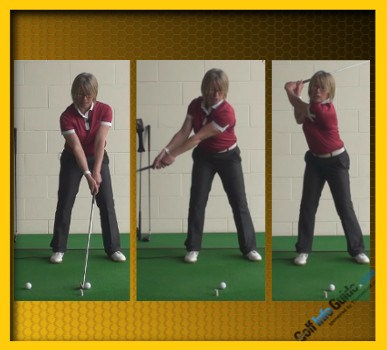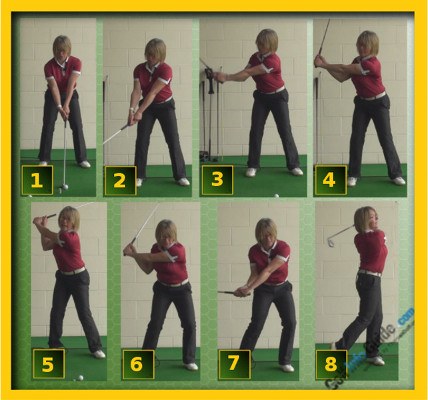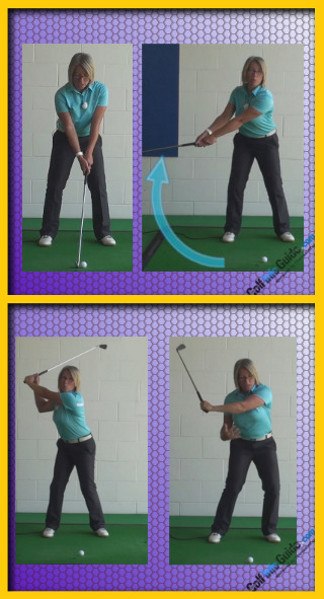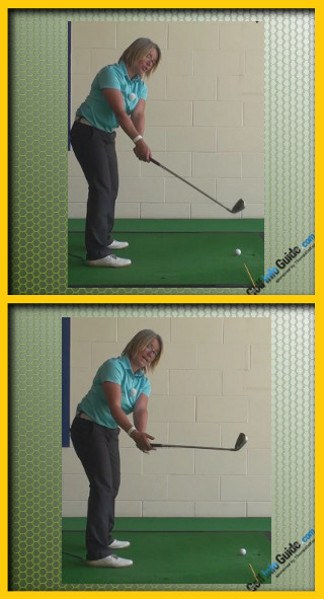
The golf swing is a process of trying to generate power and consistency. The wider the arc of the swing, the more power can be generated. Therefore, the takeaway of the swing should encourage the club to follow the widest arc possible for each individual golfer.
From a nice address position, the focus should be on turning the left shoulder under the chin for the right-handed golfer. If the left arm is maintained in a straight position at the hand, and arm action is relatively passive and minimal, the club should remain on a low and slow arc away from the golf ball. This creates a wide powerful and consistent backswing turn.
This movement becomes more and more important for the longer golf clubs, therefore, a really nice exercise to improve this movement is to set up to a tee peg for a normal driver swing but just remove the ball. Then work on dragging the golf club back across the floor for around 2 feet of the backswing before the club is lifted off the ground. This sets the feeling of a wide arcing backswing, then swing down brushing the tee peg and repeat.
If you have a tendency to pick up or lift the club off the ground too aggressively, you may notice this is caused by overactive hands or arms and results in a narrower, less powerful, less consistent backswing motion.

Golf Fix – Take the Club Back Low and Slow for Correct Connected Swing
The takeaway is easily the most-overlooked part of the golf swing. Most players choose to focus their time and energy on improving their transition or their impact position, and those are important – but without a good takeaway, no amount of practice will enable you to hit quality shots. Building a good takeaway is important, yet the average golfers tends to ignore it during their practice routines. If you can commit yourself to spending the necessary time to create a proper takeaway in your connected-golf-swing-how-can-i-develop-one/”>swing, you will instantly have a leg up on the competition.
You will be happy to hear that a good takeaway is actually a simple motion, and one that you should be able to learn in just a few practice sessions. In fact, two words can accurately sum up what you should be trying to achieve in the takeaway – low and slow. The 'low' refers to keeping the club head low to the ground during the first few inches of the swing, while the 'slow' refers to the pace of your takeaway. If you can hit on just those two points, you are almost certainly going to make a great move away from the ball. Of course, most golfers miss on one or both of these objectives, leading to a takeaway that does more harm than good.
No matter what you are going to do with the rest of your swing, it should all get started with a low and slow move back from the ball. Most likely, your current takeaway is both too fast and too high off the ground. Moving the club away from the ball too quickly is a common mistake, usually due to the excitement of getting ready to hit a shot. The ability to control your emotions and make a slow takeaway even under pressure is a valuable skill to develop. As for getting the club too high off the ground, your hands can be blamed for that mistake. Engaging your hands early in the backswing will lift the club head off the ground, getting it out of position for the rest of the backswing. Ideally, you will keep your hands quiet will allowing your shoulders to rotate the club into the backswing. Quiet hands and a slow tempo early in the swing are characteristics that almost all good golfers share.
Even after you have improved your tempo on the driving range, there will still be work to do if you want that progress to translate out onto the course. It is easy to fall back into old habits on the course, especially when it comes to your takeaway. The best way to counter this problem is through sheer repetitions. Spend plenty of time on the practice range getting comfortable with your new tempo so it will be second nature when you decide to head out for a round.
All of the instruction below is based on a right handed golfer. If you happen to play left handed, please reverse the directions as necessary.

Establishing a Slow Takeaway Tempo
To get started improving your takeaway, first work on the 'slow' part of the equation. Once you have a nice tempo in place, you can add in the 'low' element to bring the whole motion together nicely. It would be a mistake to work on both of them right away, as your mind should be fully focused on fixing one problem at a time.
You don't need to be at the golf course to work on your takeaway tempo. The work that needs to be done can be completed anywhere you have space to make some practice swings – such as your backyard. There is no need to hit balls at this point, since the entire takeaway will not yet be in place. It is best to wait on hitting practice balls until the whole takeaway has been installed.
Follow the steps below to develop a slow tempo in your takeaway motion.
- Find a space where you can make some practice swings without having to worry about hitting anything (or anyone). You can certainly be at the driving range to work on this drill, but you can also do it at home if you have the space available to swing.
- Take any one of your clubs out of the bag and get into your address position. Just because you won't be hitting any shots during this drill doesn't mean that you can slack off on your fundamentals. Make the effort to get into a comfortable, athletic stance with great balance between your feet. If it helps, you can pick a target off in the distance to use for an aiming point.
- Once you are settled into your stance, take your left hand off the club so you are only holding onto the grip with your right hand. Put your left hand in your pocket, or behind your back.
- With just your right hand, start the club in motion slowly. You are only going to move the club back away from your address position by about six inches, but those six inches should take about one second to cover. Once you are six inches or so back from address, reverse the motion and take the club back to your address position. Go back and forth several times, moving the club slowly each time.
- After completing several takeaway repetitions with just your right hand, switch it up and put the club in only your left hand. Repeat the process from above, moving the club back and forth approximately six inches behind the ball. Again, you should be moving rather slowly at this point, simply trying to feel the sensation of using a smooth tempo to take the club away from the ball.
- Continue switching back and forth between your right and left hand as many times as you would like. This is a handy drill to use when you are bored around the house, or when you are warming up prior to hitting some balls on the range.
The idea behind this drill is simple – with only one hand on the club, you won't have as much control over the motion of the club, and therefore you will naturally move it slower during the takeaway. If you were to practice your takeaway only with two hands, you might have a tough time feeling the correct speed for the early stage of your swing. Spend plenty of time working on one-handed takeaways until you are happy with your tempo, and then try to recreate that tempo using both hands.

Keeping the Club Head Low to the Ground
With the slow tempo in place, the other half of this puzzle is keeping the club head low to the ground during the takeaway. Obviously, the club head needs to lift up into the air at some point in the backswing, so it is really only important to keep it low to the ground for the first six inches or so of the swing. As long as you get off to a good start by staying low to the ground, the rest of the backswing should fall into place.
While the goal is the same for everyone – keep the club head low to the ground – each individual golfer will have their own unique way of making that happen. You still need to maintain the characteristics of your swing that allow you to strike the ball solidly, so you don't want to take on a complete overhaul just to keep the club head lower during the takeaway. Small adjustments are almost always better than major changes in golf, so start by tweaking your technique and continue to make changes until the takeaway looks exactly as it should.
Following are three tips that you can use to keep the club head lower during the very beginning stages of the swing.
- Relax your grip. The club head is going to get too far off the ground when your hands are too active in the takeaway. You should be trying to use your shoulders and arms more than your hands early in the swing, and relaxing your grip will help you do just that. Having a lower grip pressure will limit your ability to lift the club head up off the ground with your hands – and that is a good thing. While it might feel uncomfortable at first, you will quickly get used to this style of swing. As you adjust to a hands-free takeaway, you will start to notice that you are making better contact with the ball, especially on iron shots.
- Stay balanced. If you allow your weight to move to the left early in your swing, the club head will naturally want to rise up off the ground as a result. Balance is key in the golf swing for a number of reasons, so it is always worth the effort to work on improving your weight distribution. You don't want your weight moving to the left early in the swing, but you don't want it moving to the right, either. Ideally, you will stay perfectly balanced throughout the backswing as you rotate the club into position. While the two things might not seem like they are connected, improved balance will almost certainly lead to a better takeaway.
- Trace an inside line. Golfers who take the club away outside of the target line will typically lift the club head up into the air – and they will often hit a slice as a result. To correct this problem, try tracing an inside line during your takeaway. It is important to note that this should not be a dramatic move to the inside. Rather, it should be a gradual arc that moves the club head slightly closer to your right foot as the backswing begins. An inside arc will not only help you keep the club head low in the takeaway, but it will also help you attack from the inside to create a powerful draw ball flight.
It is important to have a slow tempo in your takeaway because that rhythm sets the stage for the rest of the swing. However, it is really the technique of keeping the club head low to the ground that will allow you to stay connected all the way through impact. A golf swing is connected when the arms and the torso are working together nicely, and that all starts with a low takeaway that keeps your arms in close to your body. Lifting the club head in the takeaway will allow your arms to get away from your side, and you may never be able to recover to become connected once again. Proper connection is a key element to making good swings, and the first step in that direction is a low takeaway.

Using Your Takeaway on the Course
As mentioned earlier, using your new and improved takeaway on the golf course is going to be more difficult than it is on the driving range. Everything in golf is harder to execute on the course, and this piece of the puzzle is no different. Don't be surprised if you struggle to use your new takeaway during the first couple of rounds you play after making these changes – that kind of transition period should be expected. Golf is a hard game, and making even small improvements can take significant time and effort.
Of course, very few golfers have the necessary patience to wait for their swing changes to take effect. Since you certainly want to see results as quickly as possible, try using the following tips to have better success when transferring your new takeaway from the driving range to the first tee.
- Slow everything down. You have made an effort to deliberately slow down your takeaway, so you don't want to throw away that work by rushing when you get onto the course. It is easy to speed up during a round and lose your rhythm. Some golfers speed up because they are nervous. Others start to play faster when they get excited, or even angry. No matter what it is that causes you to pick up speed on the course, you need to find a way to reverse that pattern as soon as you can. You want to keep your tempo even throughout all 18 holes – especially in your takeaway. Before each swing, take a deep breath and slow down your thinking so you can execute your takeaway, and the rest of the swing, properly.
- Improve your focus. Almost every amateur golfer is guilty of losing focus from time to time throughout a round. After all, a round of golf frequently takes four hours or more to complete, and it can be difficult to keep your mind focused on a single task for that length of time. The key to maintaining focus is to actually allow yourself to lose focus – but only at the right times. While you are walking down the fairway between shots, it is perfectly acceptable to allow your mind to wonder onto other topics. Chat with the people you are playing with, enjoy the scenery around you, or simply clear your mind as you breathe in some fresh air. Taking a 'mental break' in between shots will make it easier to focus sharply when necessary. Once you arrive at your ball and prepare to hit your shot, your mind should be focused in on the task at hand. That focus should include thinking about the improved technique that you have installed in your takeaway. If you can focus your mind prior to each swing for an entire round, you will be impressed with the results. It isn't necessary to focus on golf for the entire four hours, but it is essential to bring your mind back to the task at hand before each swing.
- Pick the right club. This is a point that every amateur golfer needs to hear over and over again. When you pick the right club for a given shot, you will be giving yourself the best chance to succeed. Unfortunately, most amateur golfers don't take enough club to cover the necessary yardage to the target. When you are selecting a club for an approach shot, for example, you shouldn't pick the club that could reach the target if you hit is absolutely perfectly. Instead, you should be hitting the next club down, allowing for some degree of miss-hit. Very few golf shots are struck perfectly, so golf is a game of managing your misses. What does this have to do with your takeaway? Everything. When you take a club that you know you have to smash in order to reach the target, your mind will instantly tell you to swing hard (and fast) to cover the distance. That simple message from your mind to your muscles is enough to ruin your takeaway. By pulling enough club, you can calm the urge to swing your hardest, and it will be easier to trust your slow takeaway to get the job done.
Even with these tips in the back of your mind, it will likely take a little bit of time to employ your new takeaway to great success on the course. Remember, hitting a few poor shots with the new takeaway isn't a reason to abandon it right away. Expect to find some bumps in the road, and stick with the process until your takeaway on the course is just as good as it is on the range.

Making an Adjustment
After all of that time and energy spent on a low and slow takeaway move in your swing, you might be surprised to learn that you aren't going to be able to use that takeaway on every shot. As you make your way around the course, you will find your ball in a variety of lies, and some of them will not allow you to use this new takeaway. Good golfers can adapt on the fly to a difficult lie, and that is a skill that you will need to develop on your way toward playing better golf.
One lie that will require an adjustment to your takeaway is the deep rough. If your ball is sitting down in some particularly deep grass, a low takeaway is a bad idea. You will get the club head stuck in the grass as you start the swing, and your tempo will be ruined. So, when playing from deep rough, it is best to engage your hands early in the swing so you can get the club head up over the top of the grass. Not only will this adjustment help your takeaway, but it will also set you up for a steeper angle of attack down into the ball – which is a great thing when playing from the rough.
You may run into other circumstances on the course, such as a lie where there is a tree root behind your ball, when you can't use your new low takeaway. The key is to be ready to adapt on the fly. You should have no trouble using your improved takeaway on the vast majority of your shots, so it really isn't a big deal if you have to adjust for one or two swings during the day. Remember, there are no pictures on the scorecard, so do what you can to get the ball back in position, regardless of what type of takeaway you need to use.
A low and slow takeaway will lead to nice connection in your golf swing, which will lead to beautiful ball striking. It is the simple elements of the golf swing that matter the most, and the takeaway is one of those simple elements that requires careful practice and attention. If you are willing to invest the time in fine tuning your takeaway using the instruction contained above, you will be rewarded with an improved golf swing – and eventually, lower scores.






